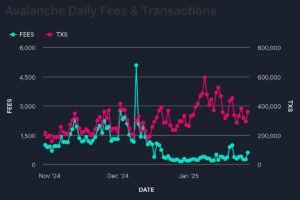- Transaction costs on Avalanche network decreased by 75% following the December 16 Avalanche9000 upgrade.
- Daily transaction volume increased by 38% to 354,691 transactions post-upgrade.
- Base fee for smart contract execution reduced from 25 nAVAX to 1 nAVAX.
- Validator requirements changed from 2,000 AVAX deposit to 1-10 AVAX monthly subscription.
- Changes aim to make the network more accessible for projects of all sizes.
The Avalanche blockchain network has experienced a significant reduction in transaction costs and a surge in activity following its recent network upgrade, according to data from Flipside and Bitquery.
The implementation of Avalanche9000 on December 16 has resulted in a 75% decrease in gas fees, while daily transactions jumped to an average of 354,691, representing a 38% increase.
This dramatic shift follows the network’s strategic move to enhance accessibility and reduce operational costs.

Avalanche, which ranks as the fifth-largest smart-contract blockchain by market capitalization, operates through a unique three-chain architecture.
The system consists of the C-Chain for smart contracts, P-Chain for staking operations, and X-Chain for asset transfers, creating a specialized ecosystem for different blockchain functions.
A key component of the upgrade, known as ACP-125, slashed the base fee for smart contract execution on the C-Chain from 25 nAVAX to 1 nAVAX (where nAVAX represents one billionth of an AVAX token).
Additionally, the network transformed its validator structure, replacing the previous 2,000 AVAX requirement with a more flexible monthly subscription model ranging from 1 to 10 AVAX.
Stephen Buttolph, Ava Labs‘ chief protocol architect, explained that the upgrade’s primary objective was to reduce costs across all components of the Avalanche technology stack, making it more accessible for developers and users alike.
This reduction in operational costs positions Avalanche to compete more effectively in the layer-1 blockchain space, where networks vie for developer attention and user adoption through optimized fee structures and enhanced performance metrics.
✅ Follow BITNEWSBOT on Telegram, Facebook, LinkedIn, X.com, and Google News for instant updates.
Previous Articles:
- Federal Reserve Chair Calls for New Congressional Framework to Regulate Crypto Market
- Bitcoin Surges Past $105K as Federal Reserve Holds Interest Rates Steady
- Hackers Target Major Sports Organization’s Social Media, Promote Fake Crypto
- Pudgy Penguins’ Abstract Layer-2 Network Sees Slow Start Despite User Incentives
- Bitcoin Surges Past $105K Following Fed’s Rate Pause Decision
